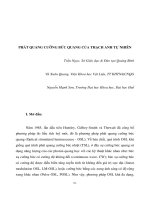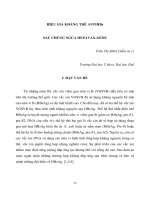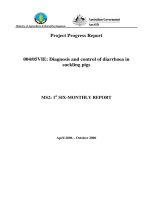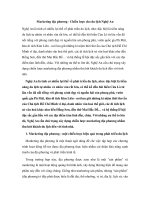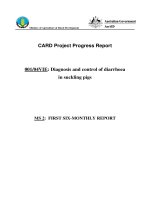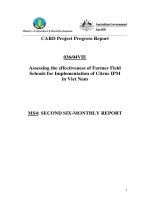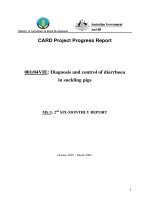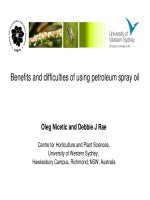Báo cáo nghiên cứu khoa học " Diagnosis and control of diarrhoea in suckling pigs - MS 2 " ppt
Bạn đang xem bản rút gọn của tài liệu. Xem và tải ngay bản đầy đủ của tài liệu tại đây (80.79 KB, 8 trang )
Ministry of Agriculture & Rural Development
CARD Project Progress Report
001/04VIE: Diagnosis and control of diarrhoea
in suckling pigs
MS 2: FIRST SIX-MONTHLY REPORT
1. Institute Information
Project Name
Diagnosis and control of diarrhoea in suckling pigs
Vietnamese Institution
National Institute of Veterinary Research (NIVR)
Vietnamese Project Team Leader
Dr. Truong Van Dung
Australian Organisation
The University of Queensland/Victorian Department of
Primary Industry
Australian Personnel
Dr Darren Trott, Dr Ian Wilkie, Dr Steve Driesen, Dr
Tony Fahy
Date commenced
April 13
th
2005
Completion date (original)
January 2007
Completion date (revised)
April 2007
Reporting period
April – October 2005
Contact Officer(s)
In Australia: Team Leader
Name:
Dr Darren Trott
Telephone:
617 336 52985
Position:
Senior Lecturer School of
Veterinary Science
Fax:
617 336 51355
Organisation
School of Veterinary Science The
University of Qld
Email:
In Australia: Administrative contact
Name:
Melissa Anderson/Katherine Burt
Telephone:
61 7 33652651
Position:
Manager Research Projects Office
Fax:
61 7 33651188
Organisation
School of Land and Food The
University of Qld
Email:
In Vietnam
Name:
Dr Cu Huu Phu
Telephone:
84 4 8693923
Position:
Head of Bacteriology Department
Fax:
84 4 8694082
Organisation
NIVR
Email:
2. Project Abstract
This project is designed to improve productivity of smallholder pig farmers in Vietnam through
improved health management, particularly of piglets during the pre-weaning period. Additional
to the health management plan the project will develop and implement appropriate rapid
diagnostic tests for the principal causes of preweaning diarrhoea to improve speed and accuracy
of laboratory diagnosis. The third part of the project seeks to improve the production and
efficacy of locally-manufactured E. coli vaccines. In the first six months of the project, test
farms have been successfully selected, management changes have been instigated and data is
currently being collected. One workshop has been conducted. Laboratory staff have been trained
and provided with rapid diagnostic reagents for identification of all the major causes of
p
reweaning diarrhoea. Diagnostic antisera is currently being produced in rabbits against the
unusual fimbrial type that appears to be unique to Vietnam, which is a necessary prerequisite for
vaccine production quality control as well as laboratory and field testing.
3. Executive Summary
This project began with three major objectives:
1. Production and testing of locally-produced vaccine
2. Develop a management plan for preweaning diarrhoea using a continuous improvement model
3. Improve diagnostics for preweaning diarrhoea
During the first six months of the project, progress has been made towards all three objectives
according to the project logframe. Vaccine strains have been characterised and diagnostic antisera
prepared against the unusual Vietnamese serotype O8 strains that appear to carry a novel
unrecognised attachment antigen. Test and control farms have been selected and audited and are
supplying production figures for the pig health recording system put in place to monitor
improvements as well as diagnostic submissions to NIVR to determine the importance of
different causes of preweaning diarrhoea. A range of management strategies have been
implemented on farm to improve environmental conditions and animal health. Members of NIVR
laboratory staff have been extensively trained and competency tested in diagnostic techniques
including bacteriology and serology, ELISA and PCR. A new PCR thermocycler was purchased
for the project and is now being extensively utilized. Several training sessions have been
delivered to producers, veterinary and industry staff.
4. Introduction & Background
Diarrhoea during the suckling period has been recognised as the principle health problem
affecting both smallholder and commercial pig production in Vietnam. Previous research has
confirmed the presence of a new fimbrial type in E. coli strains causing colibacillosis in Vietnam
that would not be controlled by existing vaccines. Existing vaccines are currently imported into
Vietnam at considerable cost. In addition, there are many other causes of suckling diarrhoea, the
significance of which is currently unknown in Vietnam, which are all affected by husbandry and
management during farrowing and lactation. Project 001/04VIE (Diagnosis and control of
diarrhoea in suckling pigs) began with three objectives to solve this problem:
1. Production and testing of locally-produced E. coli vaccines
2. Development of a management plan for preweaning diarrhoea using a continuous improvement
(CIP) model
3. Improved field and laboratory diagnosis of preweaning diarrhoea
5. Progress to Date
5.1 Implementation Highlights
1) Australian study tour by Vietnamese scientists March 12
th
to 30
th
2005
a) Brisbane: Tour of University of Qld School of Veterinary Science, University of Qld
Molecular Biosciences Precinct and Department of Primary Industry Toowoomba Veterinary
Diagnostic Laboratory (Introduction to veterinary diagnostics and Australian animal health
surveillance network). In addition, we organised for a shipment of surplus laboratory equipment
items and consumables held at the TVL to be sent to NIVR.
b) Bendigo: Pig Health and Research Unit and autogenous vaccine production laboratory,
Intervet Ltd Commercial Vaccine Manufacturing plant, visits to various piggeries (technology
transfer of rapid diagnostic tests, vaccine production, transfer of surplus equipment and
consumables).
2) First study tour of Vietnam by Australian scientists.
All Australian collaborators attended a meeting of stakeholders on the 16
th
April 2005 at the
National Institute of Veterinary Research to discuss the project aims and objectives. The
following milestones were achieved during this visit.
a) Technology transfer and provision of reagents to NIVR staff for laboratory
diagnosis. Methodologies were developed for diagnosis of colibacillosis (microbiological
techniques, diagnostic antisera and PCR protocols), Clostridium perfringens (microbiological
techniques), coccidiosis (faecal floats for egg counts), rotavirus and transmissible gastroenteritis
(diagnostic ELISA kits). A sample submission form for the project was designed and
implemented and laboratory results obtained for specimens taken during the farm visits in Thai
Binh province, which served the purpose of providing specimens for training of NIVR laboratory
personnel (see farm audits for laboratory results). During the six-month project, a total of 154
swab specimens and 65 faecal specimens have been received.
b) Selection of test and control piggeries in Thai Binh province and in the South.
Several large farms were visited and assigned to test or control groups for the purpose of
recording production data (data loggers were placed in two of the farms), with the long-term goal
of turning the test farms into model piggeries for training purposes. Sow cards were introduced
for the purpose of accurate record keeping. The farms were audited by Australian scientists and
faecal specimens were obtained from any suckling pigs with diarrhoea for laboratory
investigation.
c) Enteric diseases workshop. The first enteric diseases workshop was delivered
simultaneously in English and Vietnamese by Dr Tony Fahy and Dr Do Ngoc Thuy to an
audience of producers, researchers and veterinarians in Thai Binh province. This was a good
opportunity to see how our methods were received and what we needed to modify for future
training workshops. Concerning the level of production and profitability of the pig industry in
Vietnam, we identified a disparity between what our audience said they were achieving and what
we actually saw on farm. Many production problems could be reduced by simple changes in
management, but these were not being adhered to. We identified that further general scientific
training of veterinarians in veterinary extension and the ability to independently conduct farm
audits, problem solve and recommend and supervise management changes was required. From
this initial workshop we formulated our philosophy of “training the trainers” for future
workshops and CARD applications for the next round.
3) Second trip to Vietnam by Australian scientists. Farm audits were conducted by Australian
scientific staff during the period of peak humidity and temperature.
4) Purchase of new PCR machine for NIVR.
A new PCR machine together with $8,000 worth of free laboratory equipment was sent to NIVR
Bacteriology Department in July 2005. This piece of equipment is now being used to rapidly
identify ETEC virulence factors in E. coli isolates from cases of colibacillosis as part of the
general improvement in enteric disease laboratory diagnosis at NIVR.
5) Further characterization of NIVR ETEC vaccine strains. Virulence factors in the selected
vaccine strains, particularly the unusual pathogenic O8 strains that express all three enterotoxins
but contain no recognised fimbriae were independently confirmed by the Pig Health and
Research Unit. Interestingly, so far we have not identified these unusual O8 strains in any of the
farms where we have conducted our audits. Contact was made with Dr John Fairbrother, St
Hyacinthe, Quebec who is the world authority on enterotoxigenic E. coli infections in pigs and he
has expressed an interest in hosting Dr Do Ngoc Thuy to conduct further studies on identifying
the unknown fimbrial antigen in the O8 strains. This will have important ramifications for the
vaccine production phase of this project, which is due to begin in January 2006.
Diagnostic antisera was prepared at NIVR in rabbits for positive identification of the unusual
serotype O8 5F- E. coli strains using standard whole cell immunization and cross absorption
methodologies. However the sera obtained from the rabbits was not specific against the 5F- O8
strains. In the second six months of the project, the immunization procedure will be repeated
using a crude fimbrial extract that may be more specific for the novel uncharacterized attachment
antigen.
At this stage of the project based on the farm audits we have undertaken, we have identified the
following major constraints on pig production in Vietnam that can be alleviated through the
adoption of our management and continuous improvement plan:
9 Lack of written production records
9 Failure to reach reproduction targets
9 Poor ventilation and cooling systems which limit the feed intake of progeny and breeders.
9 Lack of written records on average daily gain, FCE, and pigs marketed /sow/yr.
9 Restrict feeding of all classes of stock from lactating sows through to finisher pigs.
9 Lack of written data on mortalities and age at death.
9 Incorrect vaccination strategies for those diseases for which there are effective vaccines.
9 Lack of specialist veterinary and extension staff to instruct and advise farmers.
9 Lack of model demonstration farms in each province to train the trainers. Binh Dinh
Department of Agriculture has offered their farm (Number 9) for such a purpose.
The final two points cannot be fulfilled during the current CARD project (001/04VIE) but are
major objectives in new project applications selected from the most recent CARD round
(004/05VIE and 020/05VIE). There is a strong possibility that these projects could be integrated
with 001/04VIE.
5.2 Smallholder Benefits
1) Improved diagnostic capability for enteric diseases at NIVR.
2) Development of model farms that will be used for smallholder farmer training workshops
during year 2 of the project.
3) Development of a training workshop advocating accurate record keeping and continuous
improvement.
3) Production of antisera to rapidly identify the unusual O8 strains and further characterization of
vaccine strains as a necessary precursor to production of a cheap, effective E. coli vaccine.
5.3 Capacity Building
During the first six months of the project, there has been a considerable investment in technology
and know-how into the NIVR bacteriology laboratory for improved, rapid diagnosis of enteric
diseases in suckling pigs. Test and control farms have now been identified for the adoption of the
management and continuous improvement plan. Further characterization of the vaccine strains
has been undertaken in preparation for production for field trials in 2006.
5.4 Publicity
An article on the initial study tour to Australia by Drs Truong Van Dung, Cu Huu Phu and Do
Ngoc Thuy appeared in the Bendigo News. Now that the project has been set up and is running
successfully, further publicity opportunities in Vietnam will be taken during a visit in January
2006 in preparation for the smallholder workshops. These will cover the creation of the model
farms, comparison of production data between test and control farms and the importance of
accurate diagnosis by NIVR scientists.
5.5
Project Management
Operational project management has been shared between the National Institute of Veterinary
Research Bacteriology Department, the Victorian Department of Primary Industry and The
University of Queensland. The Faculty Research Projects Office in the School of Land and Food
at The University of Queensland, who have many years experience in managing international
agricultural research projects, is responsible for administration of the project.
6. Report on Cross-Cutting Issues
6.1 Environment
Some attention to piggery waste disposal has been made during the initial farm audits (for
example, the observation that piggeries using open flush systems may be more susceptible to
disease outbreaks). As management changes are initiated following further farm audits, improved
feed conversion, reduced disease and improved production will all have a positive effect on
environmental waste. The majority of scouring piglets are still treated with antimicrobials, which
may in many cases be inappropriate, considering that only a small number of cases of E. coli
colibacillosis (neonatal diarrhoea at 1-4 days and 2-3 week old scours) and Clostridium
perfringens enterotoxaemia have been diagnosed in specimens submitted to NIVR from our test
and control piggeries. Recommending treatment with Baycox at 3-4 days instead of at 7 days will
limit the production limiting effects of coccidiosis. Improvements in farrowing pen management
and creep design are also likely to have an effect on endemic TGE and rotavirus, which appear to
be quite common. Inappropriate usage of antimicrobials is likely to promote the development of
resistance, therefore implementation of our management plan is likely to result in reduced
reliance on antimicrobials.
During the smallholder workshops planned for 2006, closer attention can be focused upon
environmental sustainability by exploring the integration of our management plan with biogas
reactors, manure composting and fish farming.
6.2 Gender and Social Issues
We have observed that women represent the majority of the labour workforce in the piggeries we
have audited. Consequently, we have noticed that the standard of hygiene in the majority of
piggeries was excellent. Improvements in production are therefore likely to have positive flow-
on benefits for gender and social issues in terms of greater job satisfaction and greater roles in
management and decision-making.
7. Implementation & Sustainability Issues
7.1 Issues and Constraints
As indicated above, the major constraint to the success of our project is the lack of appropriately
trained veterinary extension workers who can conduct independent farm audits accurately and
efficiently so that necessary management changes will be adopted to improve production and
profitability.
7.2 Options
We are in the process of developing a farm audit checklist that can be used to “train the trainers”
as well as give an objective assessment of the major constraints to production at each farm
visited. Use of this checklist will enable our scientists to evaluate the level of competency of
Vietnamese personnel conducting the audit. However, to fully implement this methodology it will
require extensive training of Vietnamese scientists in Australia, which is being undertaken in the
new CARD projects (004/05VIE and 020/05VIE).
7.3 Sustainability
Not applicable to comment on at this stage of the project.
8. Next Critical Steps
Key steps in the next six months of the project:
1) Production and efficacy testing of locally produced E. coli vaccine
2) Field trials of new vaccine on test piggeries
3) Preparation of smallholder workshops and field days to be delivered in 2006 based
on the management and continuous improvement model developed on large
piggeries
4) Organise publicity of project in Vietnam
5) Extensive consultation with MARD representatives to utilize existing networks for
delivery of outcomes (National Centre for Veterinary Extension)
9. Conclusion
At this stage of the project, all the initial objectives have been achieved. We have identified a
major constraint to full implementation of our management plan (appropriate training of
veterinary extension workers). Our current budget is not enough to cover the extra cost of
intensively training this small number of high potential young Vietnamese scientists, however
funds are available for this purpose in the new CARD projects. There are excellent opportunities
for integrating the three CARD projects focusing on improving the livelihood and profitability of
smallholder pig producers. The Australian team now assembled has considerable expertise and
experience (ie Australia’s leading pig health and production experts), to transfer to Vietnamese
scientists, thus enabling them to drive the continuous improvement model.
